The 8-Step Problem-Solving Method

- November 22, 2021

Table Of Contents
What is the 8-step problem-solving method, the 8 steps and the problem-solving process, the culture of problem-solving.
- Plan, Do, Check, Act (PDCA)
- Gain Problem-Solving Support
As a manufacturing professional, you know how important it is to stay organized, keep your goals in mind and strive for success. But with all of the responsibilities and daily tasks piling up, it takes effort to find and stick to a process that can keep you on track.
Luckily, there’s a tried and trusted way to achieve success in the manufacturing industry.
The eight-step problem-solving process is a structured method that guides you through the various steps of solving issues. Unlike other problem-solving processes that are often broad, the eight-step method takes you through each individual step, from identifying the problem to taking actionable steps to success.
Instead of changing a few things at a middling level that will probably break down again later, you can unearth the roots of problems and build success from the ground up.
For a fundamental breakdown of how to fix problems and lead your manufacturing team to success, here are the eight steps of the problem-solving process.
1. Identify the Problem
The first step in the process is to identify the problem. Identify why this is a problem, how you discovered it and how it impacts your business. Also note when the problem started and how long it has been going on.
If the problem is small, you can try to contain it and may not need additional steps to fix it. However, if the problem is complex, move forward through the process.
2. Define the Problem
The next step involves breaking down the problem and defining what it is. It’s important to be as clear as you can with this step — a vague problem will hinder the process, whereas a clearly defined issue will allow you to take actionable steps to fix it.
Analyze factors like how high of a priority it is to solve the problem. You can also look to data and other resources to clarify or help you understand the concern.
3. Make a Goal
Create an end goal. Envision what fixing this problem would look like and feel like. What would it accomplish? How would it help you? Map out all the ways fixing this problem would benefit you and use it for motivation to achieve your goal. Set a timeline to figure how long it will take to accomplish that goal.
4. Find the Root of the Problem
Often problems are byproducts of deeper, more central problems, so make sure you dig deep enough to find out what is really causing the issue. If the problem is large and complex, break it down into individual parts.
Gather information and use it to identify the deeper issues of the problem and validate what you think the real concern may be. Take time at this step to really focus on the deep problem — executing this step effectively will save you a lot of time down the road.

5. Develop Actionable Steps
Create a list of realistic steps you can take to combat the problem. You can start with a large list and combine or subtract steps, but it’s important you come up with various ways to attack the problem. Use this action plan to draw up a strategy to get at the root of the problem. Each step should be specific and detail-focused — any steps that are vague or tedious will only take up time and cause confusion.
6. Execute Steps
Now that the plan is in place, all you have to do is follow through on your actionable steps. Illustrate the steps you’re taking to your team, explain why you’re taking them and delegate any steps that another employee has to perform to execute your plan.
Communication is key in this step. In most cases, you won’t be executing the plan all by yourself, so make sure you’re expressing the goals and motives of each step with your team so they can see how it connects to the bigger picture.
7. Observe and Evaluate
Monitor your strategy carefully and see how it relates to the original problem. Is it working? Is it only creating more problems? Gather data, talk to your team and be thorough and objective in your evaluation. You might have to readjust your plan as you gain new information, or you may meet your goals and the plan will be successful.
8. Continue the Process
If the plan worked, find ways to continue integrating these steps into your team’s daily routine. If they didn’t work, go back to the goal-setting process or identify some more aspects of the problem — there may be a deeper concern you missed the first time around. Communicate to your team about how the plan went.
In the future, continue using the eight-step process to solve issues and build momentum with your team.
It’s important to build a culture of problem-solving in your manufacturing plant. It can be easy to fall into the trap of “Band-Aid” solutions — quick fixes without digging into the deeper problems.
It’s believed that the eight-step problem-solving process was actually created by the Toyota Motor Corporation to achieve their admired production standards.
From the lore of Toyota, we get some great eight-step problem-solving examples. Taiichi Ohno , the father of the Toyota Production System, observed his workers fixing only the first level of cause when their machines stopped working. To combat this, he developed a problem-solving method to methodically break down each problem of the machine until he found the root cause. Only then could he truly fix the machine.
It’s one of many eight-step problem-solving examples, and it shows the importance of creating a process to increase productivity.
Plan, Do, Check, Act (PDCA) and the 8-Step Problem-Solving Process Differences
The eight-step problem-solving process is an expanded version of the Plan, Do, Check, Act cycle . The first five steps of the 8-step process fall under the planning step, while steps six, seven and eight all correspond to the do, check and act steps. The eight-step process is a more detailed, methodical version of PDCA problem-solving, and converts a vague cycle into something a bit more specific and actionable.

Gain the Problem-Solving Support You Need With MANTEC
MANTEC is the best resource center for manufacturing companies in South Central Pennsylvania. We’re a non-profit that solves any problems a manufacturing facility could have, including sales and marketing , process improvement , manufacturing technology and workforce engagement .
Our expert staff has had vast experience in the manufacturing industry, and we can provide the guidance you need to get your business running at top efficiency. Our services are affordable and extremely valuable. Contact us today!
Related Posts

Struggling to manage multiple payment systems for different business needs (B2B, B2C, D2C)? Payment Hub…

In the dynamic landscape of business, achieving and maintaining an International Organization for Standardization (ISO)…

Manufacturers need to build agility into their businesses and processes to respond and recover faster…

What is Problem Solving? (Steps, Techniques, Examples)
By Status.net Editorial Team on May 7, 2023 — 5 minutes to read
What Is Problem Solving?
Definition and importance.
Problem solving is the process of finding solutions to obstacles or challenges you encounter in your life or work. It is a crucial skill that allows you to tackle complex situations, adapt to changes, and overcome difficulties with ease. Mastering this ability will contribute to both your personal and professional growth, leading to more successful outcomes and better decision-making.
Problem-Solving Steps
The problem-solving process typically includes the following steps:
- Identify the issue : Recognize the problem that needs to be solved.
- Analyze the situation : Examine the issue in depth, gather all relevant information, and consider any limitations or constraints that may be present.
- Generate potential solutions : Brainstorm a list of possible solutions to the issue, without immediately judging or evaluating them.
- Evaluate options : Weigh the pros and cons of each potential solution, considering factors such as feasibility, effectiveness, and potential risks.
- Select the best solution : Choose the option that best addresses the problem and aligns with your objectives.
- Implement the solution : Put the selected solution into action and monitor the results to ensure it resolves the issue.
- Review and learn : Reflect on the problem-solving process, identify any improvements or adjustments that can be made, and apply these learnings to future situations.
Defining the Problem
To start tackling a problem, first, identify and understand it. Analyzing the issue thoroughly helps to clarify its scope and nature. Ask questions to gather information and consider the problem from various angles. Some strategies to define the problem include:
- Brainstorming with others
- Asking the 5 Ws and 1 H (Who, What, When, Where, Why, and How)
- Analyzing cause and effect
- Creating a problem statement
Generating Solutions
Once the problem is clearly understood, brainstorm possible solutions. Think creatively and keep an open mind, as well as considering lessons from past experiences. Consider:
- Creating a list of potential ideas to solve the problem
- Grouping and categorizing similar solutions
- Prioritizing potential solutions based on feasibility, cost, and resources required
- Involving others to share diverse opinions and inputs
Evaluating and Selecting Solutions
Evaluate each potential solution, weighing its pros and cons. To facilitate decision-making, use techniques such as:
- SWOT analysis (Strengths, Weaknesses, Opportunities, Threats)
- Decision-making matrices
- Pros and cons lists
- Risk assessments
After evaluating, choose the most suitable solution based on effectiveness, cost, and time constraints.
Implementing and Monitoring the Solution
Implement the chosen solution and monitor its progress. Key actions include:
- Communicating the solution to relevant parties
- Setting timelines and milestones
- Assigning tasks and responsibilities
- Monitoring the solution and making adjustments as necessary
- Evaluating the effectiveness of the solution after implementation
Utilize feedback from stakeholders and consider potential improvements. Remember that problem-solving is an ongoing process that can always be refined and enhanced.
Problem-Solving Techniques
During each step, you may find it helpful to utilize various problem-solving techniques, such as:
- Brainstorming : A free-flowing, open-minded session where ideas are generated and listed without judgment, to encourage creativity and innovative thinking.
- Root cause analysis : A method that explores the underlying causes of a problem to find the most effective solution rather than addressing superficial symptoms.
- SWOT analysis : A tool used to evaluate the strengths, weaknesses, opportunities, and threats related to a problem or decision, providing a comprehensive view of the situation.
- Mind mapping : A visual technique that uses diagrams to organize and connect ideas, helping to identify patterns, relationships, and possible solutions.
Brainstorming
When facing a problem, start by conducting a brainstorming session. Gather your team and encourage an open discussion where everyone contributes ideas, no matter how outlandish they may seem. This helps you:
- Generate a diverse range of solutions
- Encourage all team members to participate
- Foster creative thinking
When brainstorming, remember to:
- Reserve judgment until the session is over
- Encourage wild ideas
- Combine and improve upon ideas
Root Cause Analysis
For effective problem-solving, identifying the root cause of the issue at hand is crucial. Try these methods:
- 5 Whys : Ask “why” five times to get to the underlying cause.
- Fishbone Diagram : Create a diagram representing the problem and break it down into categories of potential causes.
- Pareto Analysis : Determine the few most significant causes underlying the majority of problems.
SWOT Analysis
SWOT analysis helps you examine the Strengths, Weaknesses, Opportunities, and Threats related to your problem. To perform a SWOT analysis:
- List your problem’s strengths, such as relevant resources or strong partnerships.
- Identify its weaknesses, such as knowledge gaps or limited resources.
- Explore opportunities, like trends or new technologies, that could help solve the problem.
- Recognize potential threats, like competition or regulatory barriers.
SWOT analysis aids in understanding the internal and external factors affecting the problem, which can help guide your solution.
Mind Mapping
A mind map is a visual representation of your problem and potential solutions. It enables you to organize information in a structured and intuitive manner. To create a mind map:
- Write the problem in the center of a blank page.
- Draw branches from the central problem to related sub-problems or contributing factors.
- Add more branches to represent potential solutions or further ideas.
Mind mapping allows you to visually see connections between ideas and promotes creativity in problem-solving.
Examples of Problem Solving in Various Contexts
In the business world, you might encounter problems related to finances, operations, or communication. Applying problem-solving skills in these situations could look like:
- Identifying areas of improvement in your company’s financial performance and implementing cost-saving measures
- Resolving internal conflicts among team members by listening and understanding different perspectives, then proposing and negotiating solutions
- Streamlining a process for better productivity by removing redundancies, automating tasks, or re-allocating resources
In educational contexts, problem-solving can be seen in various aspects, such as:
- Addressing a gap in students’ understanding by employing diverse teaching methods to cater to different learning styles
- Developing a strategy for successful time management to balance academic responsibilities and extracurricular activities
- Seeking resources and support to provide equal opportunities for learners with special needs or disabilities
Everyday life is full of challenges that require problem-solving skills. Some examples include:
- Overcoming a personal obstacle, such as improving your fitness level, by establishing achievable goals, measuring progress, and adjusting your approach accordingly
- Navigating a new environment or city by researching your surroundings, asking for directions, or using technology like GPS to guide you
- Dealing with a sudden change, like a change in your work schedule, by assessing the situation, identifying potential impacts, and adapting your plans to accommodate the change.
- How to Resolve Employee Conflict at Work [Steps, Tips, Examples]
- How to Write Inspiring Core Values? 5 Steps with Examples
- 30 Employee Feedback Examples (Positive & Negative)
- Bipolar Disorder
- Therapy Center
- When To See a Therapist
- Types of Therapy
- Best Online Therapy
- Best Couples Therapy
- Managing Stress
- Sleep and Dreaming
- Understanding Emotions
- Self-Improvement
- Healthy Relationships
- Student Resources
- Personality Types
- Sweepstakes
- Guided Meditations
- Verywell Mind Insights
- 2024 Verywell Mind 25
- Mental Health in the Classroom
- Editorial Process
- Meet Our Review Board
- Crisis Support
Overview of the Problem-Solving Mental Process
- Identify the Problem
- Define the Problem
- Form a Strategy
- Organize Information
- Allocate Resources
- Monitor Progress
- Evaluate the Results
Frequently Asked Questions
Problem-solving is a mental process that involves discovering, analyzing, and solving problems. The ultimate goal of problem-solving is to overcome obstacles and find a solution that best resolves the issue.
The best strategy for solving a problem depends largely on the unique situation. In some cases, people are better off learning everything they can about the issue and then using factual knowledge to come up with a solution. In other instances, creativity and insight are the best options.
It is not necessary to follow problem-solving steps sequentially, It is common to skip steps or even go back through steps multiple times until the desired solution is reached.
In order to correctly solve a problem, it is often important to follow a series of steps. Researchers sometimes refer to this as the problem-solving cycle. While this cycle is portrayed sequentially, people rarely follow a rigid series of steps to find a solution.
The following steps include developing strategies and organizing knowledge.
1. Identifying the Problem
While it may seem like an obvious step, identifying the problem is not always as simple as it sounds. In some cases, people might mistakenly identify the wrong source of a problem, which will make attempts to solve it inefficient or even useless.
Some strategies that you might use to figure out the source of a problem include :
- Asking questions about the problem
- Breaking the problem down into smaller pieces
- Looking at the problem from different perspectives
- Conducting research to figure out what relationships exist between different variables
2. Defining the Problem
After the problem has been identified, it is important to fully define the problem so that it can be solved. You can define a problem by operationally defining each aspect of the problem and setting goals for what aspects of the problem you will address
At this point, you should focus on figuring out which aspects of the problems are facts and which are opinions. State the problem clearly and identify the scope of the solution.
3. Forming a Strategy
After the problem has been identified, it is time to start brainstorming potential solutions. This step usually involves generating as many ideas as possible without judging their quality. Once several possibilities have been generated, they can be evaluated and narrowed down.
The next step is to develop a strategy to solve the problem. The approach used will vary depending upon the situation and the individual's unique preferences. Common problem-solving strategies include heuristics and algorithms.
- Heuristics are mental shortcuts that are often based on solutions that have worked in the past. They can work well if the problem is similar to something you have encountered before and are often the best choice if you need a fast solution.
- Algorithms are step-by-step strategies that are guaranteed to produce a correct result. While this approach is great for accuracy, it can also consume time and resources.
Heuristics are often best used when time is of the essence, while algorithms are a better choice when a decision needs to be as accurate as possible.
4. Organizing Information
Before coming up with a solution, you need to first organize the available information. What do you know about the problem? What do you not know? The more information that is available the better prepared you will be to come up with an accurate solution.
When approaching a problem, it is important to make sure that you have all the data you need. Making a decision without adequate information can lead to biased or inaccurate results.
5. Allocating Resources
Of course, we don't always have unlimited money, time, and other resources to solve a problem. Before you begin to solve a problem, you need to determine how high priority it is.
If it is an important problem, it is probably worth allocating more resources to solving it. If, however, it is a fairly unimportant problem, then you do not want to spend too much of your available resources on coming up with a solution.
At this stage, it is important to consider all of the factors that might affect the problem at hand. This includes looking at the available resources, deadlines that need to be met, and any possible risks involved in each solution. After careful evaluation, a decision can be made about which solution to pursue.
6. Monitoring Progress
After selecting a problem-solving strategy, it is time to put the plan into action and see if it works. This step might involve trying out different solutions to see which one is the most effective.
It is also important to monitor the situation after implementing a solution to ensure that the problem has been solved and that no new problems have arisen as a result of the proposed solution.
Effective problem-solvers tend to monitor their progress as they work towards a solution. If they are not making good progress toward reaching their goal, they will reevaluate their approach or look for new strategies .
7. Evaluating the Results
After a solution has been reached, it is important to evaluate the results to determine if it is the best possible solution to the problem. This evaluation might be immediate, such as checking the results of a math problem to ensure the answer is correct, or it can be delayed, such as evaluating the success of a therapy program after several months of treatment.
Once a problem has been solved, it is important to take some time to reflect on the process that was used and evaluate the results. This will help you to improve your problem-solving skills and become more efficient at solving future problems.
A Word From Verywell
It is important to remember that there are many different problem-solving processes with different steps, and this is just one example. Problem-solving in real-world situations requires a great deal of resourcefulness, flexibility, resilience, and continuous interaction with the environment.
Get Advice From The Verywell Mind Podcast
Hosted by therapist Amy Morin, LCSW, this episode of The Verywell Mind Podcast shares how you can stop dwelling in a negative mindset.
Follow Now : Apple Podcasts / Spotify / Google Podcasts
You can become a better problem solving by:
- Practicing brainstorming and coming up with multiple potential solutions to problems
- Being open-minded and considering all possible options before making a decision
- Breaking down problems into smaller, more manageable pieces
- Asking for help when needed
- Researching different problem-solving techniques and trying out new ones
- Learning from mistakes and using them as opportunities to grow
It's important to communicate openly and honestly with your partner about what's going on. Try to see things from their perspective as well as your own. Work together to find a resolution that works for both of you. Be willing to compromise and accept that there may not be a perfect solution.
Take breaks if things are getting too heated, and come back to the problem when you feel calm and collected. Don't try to fix every problem on your own—consider asking a therapist or counselor for help and insight.
If you've tried everything and there doesn't seem to be a way to fix the problem, you may have to learn to accept it. This can be difficult, but try to focus on the positive aspects of your life and remember that every situation is temporary. Don't dwell on what's going wrong—instead, think about what's going right. Find support by talking to friends or family. Seek professional help if you're having trouble coping.
Davidson JE, Sternberg RJ, editors. The Psychology of Problem Solving . Cambridge University Press; 2003. doi:10.1017/CBO9780511615771
Sarathy V. Real world problem-solving . Front Hum Neurosci . 2018;12:261. Published 2018 Jun 26. doi:10.3389/fnhum.2018.00261
By Kendra Cherry, MSEd Kendra Cherry, MS, is a psychosocial rehabilitation specialist, psychology educator, and author of the "Everything Psychology Book."

Guide: 8D Problem Solving
Author: Daniel Croft
Daniel Croft is an experienced continuous improvement manager with a Lean Six Sigma Black Belt and a Bachelor's degree in Business Management. With more than ten years of experience applying his skills across various industries, Daniel specializes in optimizing processes and improving efficiency. His approach combines practical experience with a deep understanding of business fundamentals to drive meaningful change.
8D Problem Solving is a systematic and structured approach used to solve business related problems. It names has been given by the fact there are 8 steps or 8 disciplines that are followed to identify, correct and eliminate recurring problems.
8D Problem Solving is regarded as robust methodology that has proven its worth across multiple industries and manufacturing in particular. The methodology was Initially developed within the automotive industry, it has since been widely adopted in manufacturing, logistics and health care to name a few. The 8D approach goes beyond helping team just identify the root cause of problem but also provides a structured approach for implementing and verifying corrective actions.
What is 8D Problem Solving?
The 8D Problem-Solving methodology was developed in the late 1980s by Ford Motor Company. The term “8D” stands for “Eight Disciplines,” which represent the eight critical steps in problem-solving.
Initially it was only intended to resolve issues within the automotive manufacturing process. However, over the year since then the methodology has gained universal acceptance and is now applied across various sectors. The 8D approach was heavily influenced by quality management systems like Total Quality Management (TQM) and methodologies like Six Sigma and forms a key part of quality roles and Six sigma qualifications.
8D is also encourages collaborative team based approach to addressing issues in the workplace This methodology was purposefully designed to be a cross-functional effort, ensuring to bring together expertise from different departments or disciplines to comprehensively address an issue by looking at it from all point of view. Here are the key components:
Preparation : Before diving into problem-solving, the team gathers all necessary resources and tools.
Team Establishment : A cross-functional team is assembled, each member having a specific role and responsibility.
Problem Description : The issue at hand is clearly defined to ensure everyone has a shared understanding.
Interim Actions : Short-term solutions are implemented to contain the problem and prevent further damage.
Root Cause Analysis : Various tools and methods are used to identify the real cause of the problem.
Permanent Corrective Actions : Long-term solutions are selected and verified to eliminate the root cause.
Implementation : The long-term solutions are implemented across the board, including necessary changes to policies and procedures.
Prevent Recurrence : Measures are taken to ensure that the problem does not occur again.
Team Recognition : The team is congratulated and acknowledged for their efforts.
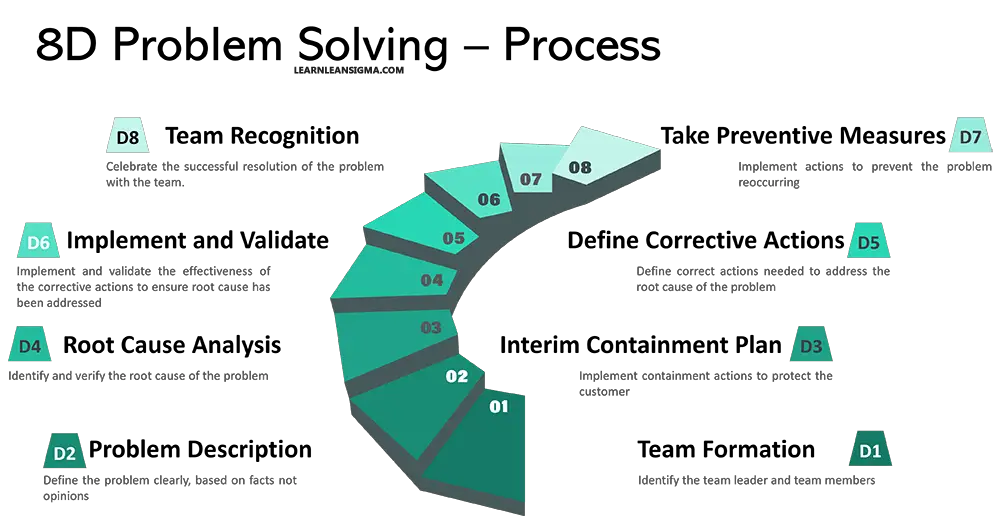
How does 8D Compare to over Problem-Solving Methods?
Between quality management systems and lean six sigma there are several problem-solving methodologies such as PDCA (Plan-Do-Check-Act), DMAIC (Define-Measure-Analyze-Improve-Control), and A3 . However the combination of the 8D steps results in a comprehensive frame work that is:
Team-Oriented : Unlike some methodologies that can be carried out by individuals, 8D strongly emphasizes team collaboration as a core principle as seen in steps D1 and D8.
Structured Framework : 8D provides a very detailed, step-by-step guide for solving complex problems, by breaking it down in to logical steps making it easier to manage and track progress.
Broad Applicability : While some methodologies like DMAIC are closely tied to Six Sigma, 8D can be applied in various contexts without being tied to a particular quality management system.
Focus on Prevention : 8D not only aims to solve the problem but also focuses on implementing changes to prevent its recurrence, making it a complete approach to problem solving.
The 8 Disciplines Explained
D0: prepare for the process.
Before you start 8D you should prepare for the 8D process. This phase sets the foundation for the entire methodology, ensuring that the team is able to tackle the problem effectively. Therefore, effective preparation helps in avoiding unnecessary delays and ensures that you’re not solving the wrong problem.
Within the initial preparation step you should also the time to think about what knowledge, expertise and experience you need within the team. Cross-functional teams are important, as they bring alternative perspectives and skills to the table rather than everyone looking at the problem from one point of view. Make sure you consider expertise, availability, and interest when selecting team members.

D1: Establish the Team
In D1 you should establish the team by clearly defining the roles and responsibilities for each team member. This includes assigning a team leader, subject matter experts, and roles for data collection , analysis, and communication this helps to provide the team members clarity on how they will be involved and contribute to the success of the problems solving activity.
Team Composition
Once roles are defined, where possible ensure that the team is balanced in terms of skills and expertise. A well-rounded team will be more effective in tackling various aspects of the problem.
Communication
Establish clear methods communication, both within the team and with external stakeholders. Such as deciding on regular meeting schedules that everyone can attend, reporting formats, and tools for collaboration.
D2: Describe the Problem
In D2 it is time to create a well formed problem statement. This step is key as it provides a foundation for understanding the problem which will lead to generally more successful problem-solving. It ensures that everyone clearly understands what needs to be addressed, setting the scope for the entire process. Ensure that the problem is clearly understood by everyone in the team at this stage to prevent confusion later on in the process.
5W1H Method of creating a Problem Definition
Use data gathering techniques such as observations, interviews, and document reviews can help to precisely identify the problem. A useful tool to use at this stage could be the 5W1H Problem definition method.
You can find out more about this method with our 5W1H guide .

Problem Definition – is / is not template
When creating your problem definition ensure to be specific, measurable, and unambiguous when stating the problem. You should avoid generalities and ensure that the problem statement is understandable to someone unfamiliar with the issue. If you are new to this process it may be helpful to give the statement to someone unfamiliar to the process and see if they understand it or if they have questions. You can then clarify any questions by adjusting the problem description to improve the claity.
D3: Implement and Verify Interim Actions
In D3 while the team is investigating the root cause, interim actions are must be implement to contain the problem and minimize its impact. This is particularly important in critical situations affecting safety, compliance, or customer satisfaction.
In this step you should identify, plan, and execute short-term fixes that can quickly contain the problem. This could include quarantining the product to ensure it is not sent out to the customer or even pausing production lines that continue to product defects. Ensure these actions are documented for future reference.
Use metrics and KPIs to gauge the effectiveness of the interim actions. Make adjustments as necessary.

D4: Root Cause Analysis
D4 is where you start to understand what is causing the issue by identifying the underlying reason for the problem. The objective is to find the root cause, not just the symptoms.
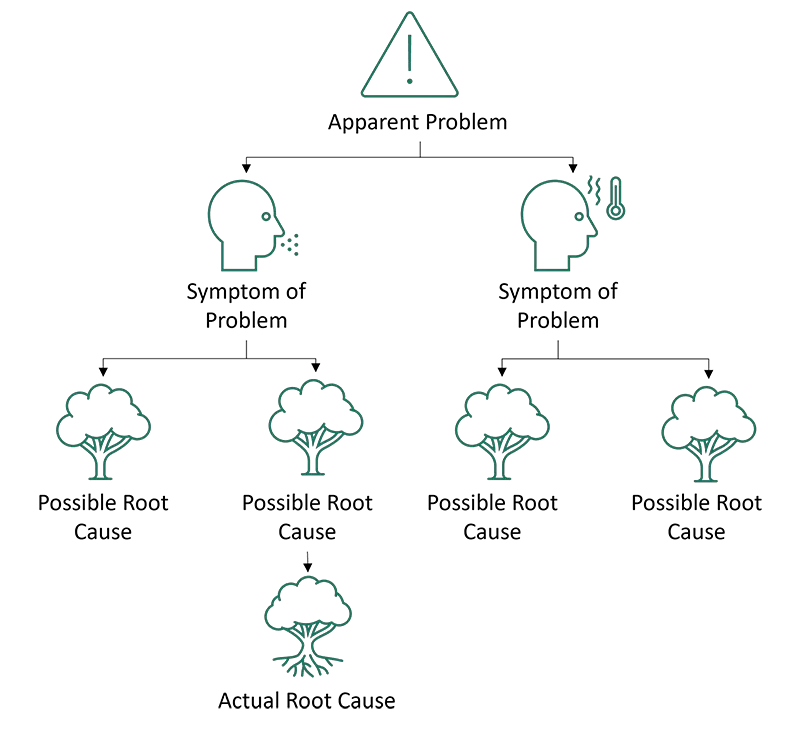
At this stage there are a range of quality and lean six sigma tools that can be used to conduct root cause analysis , which can include the Fishbone Diagram for structured brainstorming and the 5 Whys technique for causal chain analysis.
We have a range of guides on all of these techniques for you to use.
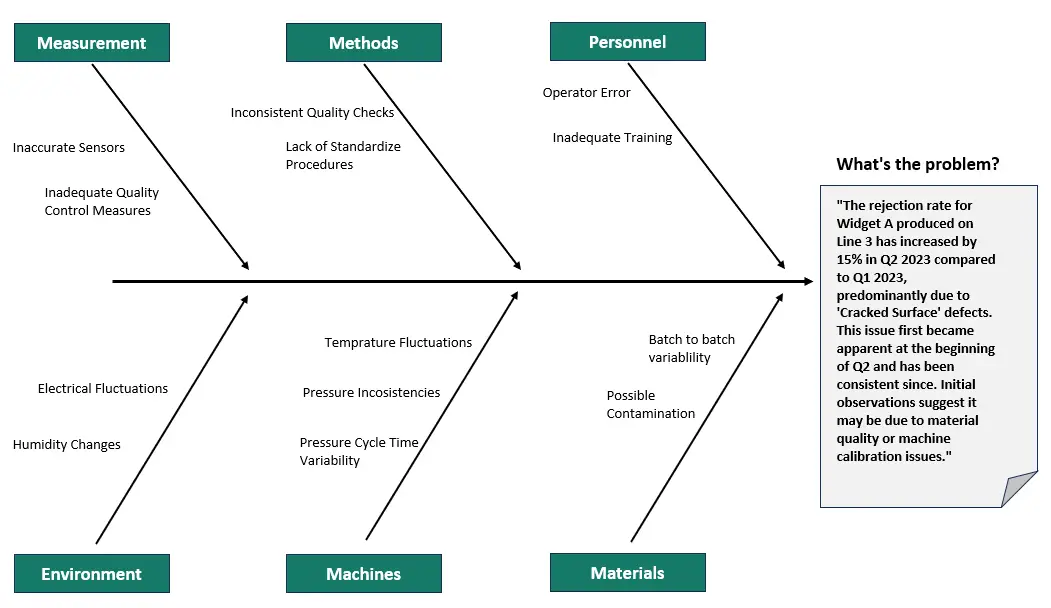
Once identified, it is important validate the root cause through experimentation or additional data analysis to ensure it’s the actual cause and not a symptom, this can often be an overlook critical step in the root cause process.
D5: Choose and Verify Permanent Corrective Actions
In D5 you need to choose what actions to be taken to prevent the problem reoccurring and any solutions implemented should be verified that the actions correct the problem this can involve trial runs, further data collection and inspections of product or services being produced.
You should also consider factors like cost, impact, and feasibility when choosing a permanent corrective action and should also conduct a risk assessment to evaluate potential negative outcomes of the actions taken
An implementation or action plan is often useful to document at this stage to detail the steps for implementation, assign responsibilities, and set timelines.
D6: Implement Permanent Corrective Actions
Once verified, implement the corrective actions across all relevant departments or processes. This can involved documenting the new process and training out to all stakeholders involved to ensure the new process is followed and that the stakeholders understand the reason for the change.
At this point you should continue to regularly monitor the situation to ensure the corrective actions are sustained and effective, this could be for a period of 30, 60 or 90 days after the problem was resolved to ensure the new process has become a sustained and issues do not reoccur.
D7: Prevent Recurrence
In D7 to prevent recurrent you should review and update organizational policies or standard operating procedures (SOPs) to prevent a recurrence of the problem and document the new standard process
It is important to conduct regular reviews to continuously monitor the process and ensure procedures are being followed but also to identify further opportunities for process improvement.
D8: Congratulate the Team
The final step D8, after the hard work and successful problem resolution, it is important to acknowledging and congratulating the team is vital for morale and future engagement. With the recognition of a successful 8D Problem-solving activity complete you are more likely to encourage future participation as the method gets a reputation as being useful and successful at solving problems.
Whether it’s a team lunch, certificates of achievement, or simply a public acknowledgment, celebrate the success in a way that resonates with your team.
Finally it is always important to conduct a lessons-learned session and document the insights gained during the process for future reference. This can be used as a future point of reference for problem solving activities.
Mastering the art of problem-solving is crucial in today’s complex and fast-paced environment. The 8D Problem-Solving methodology offers a structured, team-based approach to tackling challenges that can arise in any sector, be it manufacturing, public services, or logistics. This guide has walked you through each of the eight disciplines, offering best practices and highlighting common pitfalls to avoid. We’ve also enriched your understanding through real-world case studies that demonstrate the methodology’s versatility and effectiveness. Remember, the strength of 8D lies not just in identifying and resolving problems, but also in preventing their recurrence through systemic improvements. By adhering to the principles and steps outlined in this guide, you’re well on your way to becoming an adept problem solver, capable of driving continuous improvement in your organization.
- Zarghami, A. and Benbow, D.W., 2017. Introduction to 8D problem solving . Quality Press.
- Camarillo, A., Ríos, J. and Althoff, K.D., 2017. CBR and PLM applied to diagnosis and technical support during problem solving in the Continuous Improvement Process of manufacturing plants . Procedia Manufacturing , 13 , pp.987-994.
Q: What is 8D problem solving?
A: 8D problem solving is a systematic approach used to address and resolve complex problems. It is widely utilized in various industries to identify the root causes of issues, develop effective solutions, and prevent their recurrence.
Q: Why is it called "8D" problem solving?
A: The name “8D” refers to the eight disciplines or steps involved in the problem-solving process. Each discipline represents a specific stage in the methodology, allowing for a structured and comprehensive approach to problem resolution.
Q: What are the eight disciplines (8D) in problem solving?
A: The eight disciplines in problem solving, often abbreviated as 8D, are as follows:
- D1: Form a team
- D2: Define the problem
- D3: Implement containment actions
- D4: Determine the root cause
- D5: Develop and implement corrective actions
- D6: Validate the effectiveness of corrective actions
- D7: Prevent recurrence
- D8: Congratulate the team
Q: What is the purpose of forming a team in the 8D problem-solving process?
A: Forming a team at the beginning of the 8D problem-solving process helps ensure that the right individuals with the necessary expertise are involved in addressing the problem. The team collaboratively works towards understanding the issue, analyzing data, and developing effective solutions.
Q: How is the root cause determined in the 8D problem-solving process?
A: Determining the root cause (D4) involves conducting a thorough analysis of the problem. Various tools and techniques, such as cause-and-effect diagrams, 5 Whys, and data analysis, are employed to identify the underlying factors contributing to the problem.
Q: Can the 8D problem-solving methodology be applied to any type of problem?
A: Yes, the 8D problem-solving methodology is a versatile approach that can be applied to various types of problems across different industries. It provides a structured framework for problem resolution and can be tailored to suit the specific needs and requirements of different situations.

Daniel Croft
Hi im Daniel continuous improvement manager with a Black Belt in Lean Six Sigma and over 10 years of real-world experience across a range sectors, I have a passion for optimizing processes and creating a culture of efficiency. I wanted to create Learn Lean Siigma to be a platform dedicated to Lean Six Sigma and process improvement insights and provide all the guides, tools, techniques and templates I looked for in one place as someone new to the world of Lean Six Sigma and Continuous improvement.
Download Template
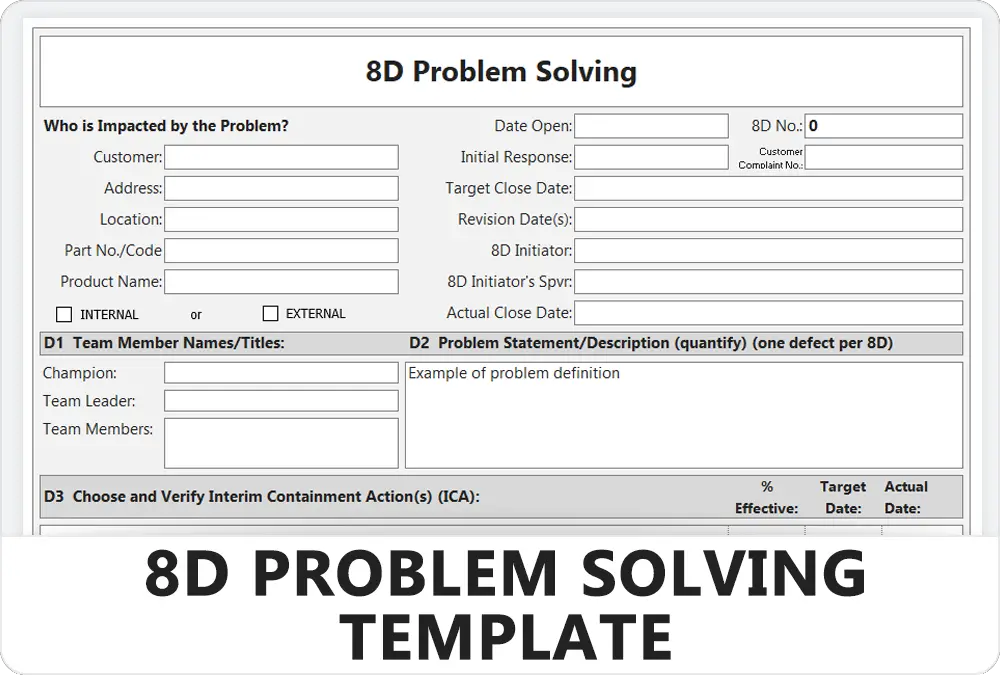
Free Lean Six Sigma Templates
Improve your Lean Six Sigma projects with our free templates. They're designed to make implementation and management easier, helping you achieve better results.
Was this helpful?

Continuous Improvement blog Problem Solving: A Structured Approach
"The problems of the world cannot be solved by thinking the same way we thought when we created them." - Albert Einstein
Problem solving is a skill that is essential for success in both personal and professional life. It is the ability to identify and articulate problems, gather information, generate solutions, and implement those solutions effectively.
There are many different approaches to problem solving, but one of the most effective is the 8-step problem-solving process. This process is structured and systematic, which helps to ensure that problems are solved efficiently and effectively.
The 8 steps of the problem-solving process are:
Define the problem
This is the first and most important step in the problem-solving process. If you do not clearly define the problem, you'll have a hard time solving it.
So how do you define a problem? Here are a few tips:
- be specific - do not just say, "the application process lead time is too long."; instead, say something like "the current lead time for the application process is 40 working days”
- use data - if you have data, use it to support your definition of the problem. For example, you could say "the average process lead time has increased by 20% in the past 6 month."
- be objective - do not let your emotions get in the way of defining the problem. For example, don't say "Our lead time is terrible." Instead, say something like "the process lead time is not meeting our customers’ expectations."
Once you've defined the problem, you'll have a much better understanding of what you need to solve. You'll also be able to narrow down the scope of the problem and identify the root cause.
Here is an example of a well-defined problem statement:
The application process lead time has increased by 20% on average to 40 days, in the past 6 months.
This problem statement is specific, uses data, and is objective. It also includes a measure, which is the 20% average increase in lead time. This measure will help to gauge the effectiveness of the final solution. Your problem statement should always include some sort of measure but no suggested solution!
Break down the problem
Once the problem has been defined, you can break it down into smaller, more manageable problems. This will make it easier to identify the root cause of the problem. For example, if the problem is that a process is not producing the desired output, you could break the problem down into the following smaller problems:
- the person in the process is not properly trained.
- the person doing the process is not processing the input correctly.
Set a target
What is the desired outcome of the problem-solving process? What are the specific goals that need to be achieved? It is important to set a clear target so that you know when the problem has been solved. For example, the target for the process problem could be to have the process producing the desired output within 24 hours.
Analyse the root cause
The root cause of the problem is the underlying issue that is causing the problem to occur. It is important to identify the root cause so that it can be addressed effectively. Several techniques can be used to analyse the root cause of a problem, such as the 5 Whys, Fishbone diagrams, and Pareto charts.
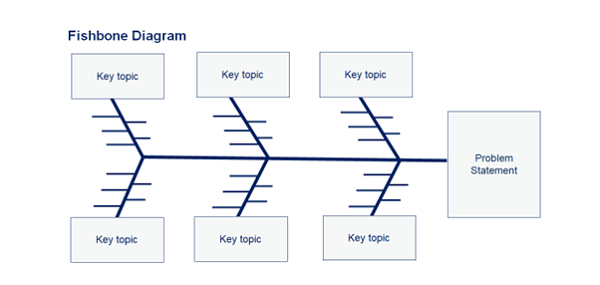
Develop Countermeasures
Once the root cause of the problem has been identified, countermeasures can be developed to address it. Countermeasures are specific actions that can be taken to prevent the problem from occurring again. For example, the countermeasures for a process problem could include:
- create Standard Operating Procedures and the “best-known way” of doing the process”
- retraining everyone in the new way of working
- create a control plan to ensure that the input information is being processed correctly 100% of the time
Implement countermeasures
The countermeasures that have been developed need to be implemented. This may involve making changes to processes, procedures, or training. It is important to monitor the implementation of the countermeasures to ensure that they are effective.
Evaluate the results
Once the countermeasures have been implemented, it is important to evaluate the results. Did the countermeasures solve the problem? If not, further action may be needed. For example, if the process problem has not been solved, you may need to identify a new root cause and develop new countermeasures.
Standardise and share lessons learned
Once the problem has been solved, it is important to standardise the solution so that it can be used to prevent the problem from occurring again. The lessons learned from the problem-solving process should also be shared so that others can benefit from them. For example, you could create a standard operating procedure for the new way of working or develop a training program for the staff involved.
By following these steps, you can solve problems more effectively and efficiently.
Here are some additional tips for problem-solving:
- be curious - be willing to investigate problems with an open mind and a desire to learn
- be collaborative - involve others in the problem-solving process to get different perspectives and ideas
- use data and evidence - make decisions about solutions based on data and evidence
- be persistent - do not give up on a problem until you have found a solution that works
- be optimistic - believe that you can solve the problem and do not be afraid to take risks
By following these tips, you can improve your problem-solving skills and become more effective in your personal and professional life.
So, what are you waiting for? Start solving some problems today.

28 July 2023
Graham Ross, Continuous Improvement Manager

More blogs by this author
Our faculties & departments
Engineering.
- Faculty of Engineering
- Architecture
- Biomedical Engineering
- Chemical & Process Engineering
- Civil & Environmental Engineering
- Design, Manufacturing & Engineering Management
- Electronic & Electrical Engineering
- Mechanical & Aerospace Engineering
- Naval Architecture, Ocean & Marine Engineering
Humanities & Social Sciences
- Faculty of Humanities & Social Sciences
- Centre for Lifelong Learning
- Government & Public Policy
- Psychological Sciences & Health
- Social Work & Social Policy
- Faculty of Science
- Computer & Information Sciences
- Mathematics & Statistics
- Pure & Applied Chemistry
- Strathclyde Institute of Pharmacy & Biomedical Sciences
- Strathclyde Business School
- Accounting & Finance
- Hunter Centre for Entrepreneurship, Strategy & Innovation
- Management Science
- MBA & General Management
- Strathclyde Executive Education & Development
- Work, Employment & Organisation
Professional services
- Access, Equality & Inclusion Service
- Careers Service
- Conferencing & Events
- Disability & Wellbeing Service
- Education Enhancement
- Equality & Diversity
- Estates Services
- Finance Directorate
- Human Resources
- Information Governance Unit
- Information Services Directorate
- Internal Audit
- Innovation & Industry Engagement
- Legal Services
- Occupational Health
- Print Services
- Procurement
- Research & Knowledge Exchange Services
- Safety, Wellbeing & Resilience
- Strategy & Planning
- Strathclyde Sport
- Student Experience
- Student Lifecycle
- Widening Access
Online services
- Student/Staff email
- KnowledgeBase
- Lab availability
- Telephone Directory
- Report IT problems & IT Service Status
- Service Catalogue
- PRO Courses Guides New Tech Help Pro Expert Videos About wikiHow Pro Upgrade Sign In
- EDIT Edit this Article
- EXPLORE Tech Help Pro About Us Random Article Quizzes Request a New Article Community Dashboard This Or That Game Happiness Hub Popular Categories Arts and Entertainment Artwork Books Movies Computers and Electronics Computers Phone Skills Technology Hacks Health Men's Health Mental Health Women's Health Relationships Dating Love Relationship Issues Hobbies and Crafts Crafts Drawing Games Education & Communication Communication Skills Personal Development Studying Personal Care and Style Fashion Hair Care Personal Hygiene Youth Personal Care School Stuff Dating All Categories Arts and Entertainment Finance and Business Home and Garden Relationship Quizzes Cars & Other Vehicles Food and Entertaining Personal Care and Style Sports and Fitness Computers and Electronics Health Pets and Animals Travel Education & Communication Hobbies and Crafts Philosophy and Religion Work World Family Life Holidays and Traditions Relationships Youth
- Browse Articles
- Learn Something New
- Quizzes Hot
- Happiness Hub
- This Or That Game
- Train Your Brain
- Explore More
- Support wikiHow
- About wikiHow
- Log in / Sign up
- Education and Communications
- Personal Development
- Problem Solving
How to Define a Problem
Last Updated: January 17, 2024 Fact Checked
This article was co-authored by Paul Chernyak, LPC . Paul Chernyak is a Licensed Professional Counselor in Chicago. He graduated from the American School of Professional Psychology in 2011. This article has been fact-checked, ensuring the accuracy of any cited facts and confirming the authority of its sources. This article has been viewed 460,410 times.
You may encounter problems often in your personal life, in your professional life, and in your community. Any sort of problem can be daunting, but taking time to define a problem may help make it easier to find solutions. Start by gathering information about the problem. Then, work on putting the problem into words. After that, analyze what you have written to look for possible solutions to the problem.
Things You Should Know
- Identify your problem by outlining what you already know about it, uncovering the information you're still missing, and finally, researching the missing information.
- Communicate the problem by writing it out, adding details, workshopping it with others to make it clearer, and if you're presenting your problem, identifying key terms.
- To solve the problem, try looking for causes, making a pros and cons list, and finally, identifying areas that you could fix.
Gathering Information About the Problem

- For example, if you are searching for a new apartment, then you could start by asking, “Why do I need a new apartment? Because my roommate is leaving, I can’t find a new roommate, and I can’t afford this apartment on my own.”
- To gather more information on child hunger in your community, you might follow this line of questioning, “Why are children in this community going hungry? Because their parents are running out of money towards the end of the month. Why are they running out of money? Because their food benefits renew at the beginning of the month.”

- For example, if you are in need of a new apartment, write down the specifics of the new apartment you need, such as when you need to move in, how much you can pay in rent each month, and where the apartment needs to be located.
- If you are trying to define the problem of child hunger in your community, then you might make a list that includes the estimated number of children affected, the areas where these children live, and where the children attend school.

- For example, if you are looking for a new apartment, then some of the information you might need could include your maximum rent per month, local apartment complexes, and the cost of utilities without a roommate.
- If you are trying to define the problem of child hunger in your area, then you might need to know how much extra food each family needs, what the shortage is in their benefit checks, and if they have any other sources of food.

- For example, if you are trying to find an apartment within a specific area and price range, visit the apartment complex’s website, check your local newspaper for apartment listings, or call a local complex and ask questions.
- If you are trying to find out why the children in your community are dealing with hunger, talk with someone from the local food bank or create a survey for parents to complete.
Putting the Problem into Words

- For example, if the problem is that you need to find a new apartment because your roommate is moving out, then you might write it as, “I need to find a new apartment because I cannot afford to live in a 2 bedroom apartment on my own and I haven’t been able to find a new roommate.”
- Another example might be, “Children in our community are going hungry towards the end of the month.”

- For example, if you are seeking a new apartment, then your tentative statement might be, “I need to find a new apartment by the end of the month because I can no longer afford this one. I need to find a 1 bedroom or studio apartment in the same neighborhood I live in now that costs no more than $700 per month.”
- If you are trying to define the problem of child hunger in your community, then you might write, “Children in this community are going hungry towards the end of the month because their parents are running out of money and food benefits.”

- If you are working with a group, ask your group members something like, “What else is missing from this statement? How could we make it stronger?” Work together to integrate the missing details.

- For example, you might need to explain what is meant by “food benefits” in a problem statement on child hunger in your community.

Finding a Solution to the Problem

- For example, if you are looking for a new apartment because of the cost, you might notice that other people have run into a similar issue. This could help you to see that the high cost of living in that neighborhood is central to your problem.
- If you are trying to determine why children in your community are going hungry, read what other people have written about it. If a common theme is the distribution of food benefits, then this is likely central to the problem.

- For example, if the high cost of a neighborhood is driven by the location and safety of the area, then these might be worth paying a little extra money for. Consider if you can find a way to work it into your budget, such as by cutting back on entertainment or another expense.
- If you are trying to define the problem of child hunger, then a possible cause might be a lack of access to affordable food in the community.

- For example, if you try to stay in an apartment you cannot afford, then you may struggle from month to month and end up in an even worse financial situation later on.
- If the problem of child hunger is not solved, then children may suffer from malnutrition and psychological trauma, which could affect them for the rest of their lives.

- For example, if you cannot afford the rent for your apartment, you are not in control of the cost of rent. However, you may be able to find some ways to save or earn more money to stay in the same neighborhood.
- If you are trying to solve child hunger in your community, you may not be able to change the way families use their food benefits. But you can provide resources to help them or supplement their food supply when they run out.
Example Problem Statements

Expert Q&A

You Might Also Like

- ↑ https://www.entrepreneur.com/leadership/defining-problems-the-most-important-business-skill-youve/237668
- ↑ https://ctb.ku.edu/en/table-of-contents/analyze/analyze-community-problems-and-solutions/define-analyze-problem/main
- ↑ https://www.cdc.gov/policy/polaris/policyprocess/problem-identification/index.html
- ↑ https://literacy.kent.edu/salt_fork/prob_solv/define_intro.html
- ↑ https://asq.org/quality-resources/problem-solving
About This Article

To define a problem, ask yourself "why" questions to get to the root of the issue. For example, your line of questioning might look something like, "Why am I having a hard time finding a new apartment? Because all of the apartments I've looked at are too expensive. Why are they all so expensive? Because I've been looking in a pricey neighborhood." Once you finish your line of questioning, you should have a better sense of what the real problem is. Then, you can define the problem so you can start coming up with a solution to it. For more advice from our co-author, like how to solve a problem once you've defined it, scroll down! Did this summary help you? Yes No
- Send fan mail to authors
Reader Success Stories
Feb 3, 2018
Did this article help you?

Maryann Mourad
Nov 14, 2022
Dec 16, 2016

Featured Articles

Trending Articles

Watch Articles

- Terms of Use
- Privacy Policy
- Do Not Sell or Share My Info
- Not Selling Info
wikiHow Tech Help Pro:
Level up your tech skills and stay ahead of the curve

Published: November 7, 2018 by Ken Feldman

It’s easy to feel overwhelmed by the number of different approaches to problem solving. Some of the most common ones are PDCA , DMAIC , A3, 6S , Agile , 5 Whys , fishbone diagrams , and others. In this article, we’ll look at the 8D process for problem-solving and process improvement. We will present the benefits of 8D along with some best practices and an example of how to use it. This will provide you with some practical applications for use in your own organization.
Overview: What is the 8D process?
The history of 8D is somewhat controversial. While everyone seems to agree that the popularity of the approach can be credited to Ford Motor company, the basis of the process is a little less clear. Senior leadership at Ford saw the need for the Powertrain division to have a methodology where teams could work on recurring problems.
In 1986, work began to develop a manual and training course that would create a new approach to solving engineering design and manufacturing problems. The title of this manual was Team Oriented Problem Solving (TOPS), and it was first published in 1987. But where did the original idea come from?
Many give credit to the U.S. War Production Board, which developed a simple, four-step approach in 1945 for improving job methods. Here’s what they looked like.
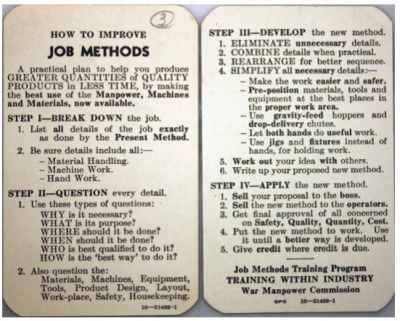
Image source: allaboutlean.com .
In reality, the 8D process is officially known as the Eight Disciplines of Problem-Solving. To make things a little more confusing, it’s really nine steps. While originally developed as 8 steps or disciplines, it was subsequently revised to include a step zero, which was to plan and prepare for solving the problem.
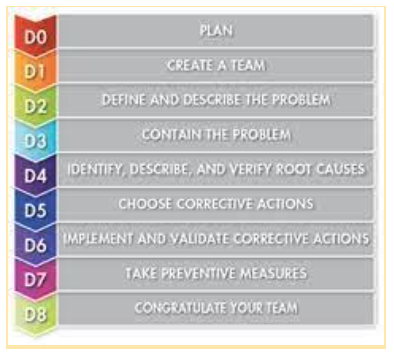
Image source: ASQ.org .
Let’s provide a little more detail for each step.
- D0 — Plan: Collect information and data on the problem symptoms. Decide what preparations will be needed to complete the 8D process. Decide whether you will need an Emergency Response Plan to minimize or mitigate the immediate impact of your problem on the customer.
- D1 — Create a team: Put together a cross-functional team consisting of a core group plus a selection of subject matter experts ( SMEs ). Be sure to provide everything the team will need to be successful, including any training needed to properly execute the process.
- D2 — Define and describe the problem: Using relevant data, describe the problem in as detail as possible. Be sure to focus on your problem at this point, not your solution.
- D3 — Contain the problem: Protect your customer by creating containment actions to prevent any further negative impact to them.
- D4 — Identify, describe, and verify root causes: You can use a multitude of tools such as the 5 Whys, fishbone diagrams, brainstorming , and others to identify potential root causes. Use data to validate your root causes.
- D5 — Choose corrective actions: Select the most appropriate actions to resolve and eliminate the root causes of your problem.
- D6 — Implement and validate your corrective actions: Implement your recommended solutions and corrective actions, and continue to monitor to assure yourself that they actually solved your problem.
- D7 — Take preventative measures: Revise your systems to proactively try to prevent these and similar problems from arising in the future.
- D8 — Congratulate your team: Communicate the work of the team and celebrate their efforts.
3 benefits of the 8D process
It goes without saying that removing problems, improving your process, and preventing future problems will provide many benefits to your organization. Here are a few.
1. Simple and effective
The 8D process has been compared to the PDCA model. Like PDCA, 8D is structured, organized, and simple in concept.
2. Drives you to the root cause
By following the sequential steps, this process should lead you to the elimination of your problem and prevent it from arising again.
3. Team approach
The use of a cross-functional team composed of a core group of people working in the problem area as well as subject matter experts contributing on an as needed basis will give you the synergy of combined knowledge and experience that should lead you to a solution.
Why is the 8D process important to understand?
While simple in concept, there are a number of things you should understand that will make this process both effective and efficient.
Elimination of the root cause
If you understand and follow the 8D steps, you will be able to eliminate — or at least mitigate — the negative impact of your problem.
Discipline
The 8D steps are sequential and build on each other. If you have the discipline to stay on track, you will optimize the use of the 8D process.
Problem-solving tools
8D is a process and methodology. You will need to understand the purpose of each step so you can apply the proper problem-solving tools in each step.
An industry example of 8D
A consumer product company located in Mexico City was experiencing an increase in its delivery trucks returning without having made product deliveries to its customers. There did not seem to be an obvious reason or solution, so the president of the company chartered a team to look into the problem. He assigned the company’s Lean Six Sigma Master Black Belt to put together and facilitate a team and chose to use the 8D problem-solving methodology.
He followed the process by first having a planning and preparation meeting to lay out the plan for analyzing the problem. He suggested that some of the delivery supervisors go out into the field to see if they can observe any unusual conditions. They also collected some data and recorded their observations.
A vigorous brainstorming session ensued in which the team listed all the possible reasons the problem was occuring. These potential root causes were validated by the data that was collected and the observations of the supervisors. They discovered the trucks were coming back without delivering all of the product because the customers didn’t have enough money to pay for the product. These were very small customers who had to pay cash on delivery.
The question then became: Why didn’t they have enough money? The next root cause was that the trucks were arriving later in the day, after the customer had already paid for most of their other deliveries and thus had no money left. Why were the trucks arriving so late? Because they got stuck in traffic because they left the yard too late. Why were they leaving so late? Because they were loading the trucks and doing the paperwork in the morning.
Eventually, the team arrived at a solution that had the trucks loaded, prepped, and ready to go when the drivers arrived early in the morning. The result was a dramatic reduction in returned goods and a significant increase in cash flow. The president was confident that the use of the 8D process got them to the right solution quickly and efficiently.
3 best practices when thinking about the 8D process
Like most of the other problem-solving approaches, there are some recommended practices that will help you and your team be successful. Here are a few that will help you stay on track.
1. Pick the best team that you can
Don’t seek volunteers, but hand-select the best team members that are available. It will be their knowledge and expertise that will make the team successful. Likewise for the team facilitator or leader.
2. Take your time
Don’t rush to solutions or what you think is the root cause of your problem. Thoroughly explore your problem so that the solutions that you eventually come up with will resolve the problem and prevent future occurrences. Think creatively.
3. Be specific about what your problem is
Use data to help you understand your problem. Don’t just rely on anecdotal stories or assumptions to decide the root cause of your problem.
Frequently Asked Questions (FAQ) about 8D
1. when should i use the 8d process.
Use this process when you’re trying to solve for safety or regulatory issues, increasing customer complaints, warranty costs (which indicate greater-than-expected failure rates), internal rejects, waste, scrap, and poor performance or test results.
2. Can the 8D process be used in non-manufacturing processes?
Yes. While the 8D process was developed in the manufacturing function of Ford Motor Company, it can just as easily be applied in any type of process or function where you are experiencing problems.
3. What is the difference between the 8D and 5D process?
For a less complex problem, you may decide to use a 5D process. This simplified process will have you form a team, identify your problem, implement containment actions, identify the root cause, and implement corrective actions to eliminate the problem.
So, what is the 8D process?
The 8D process, also known as the Eight Disciplines of Problem Solving, is a method developed at Ford Motor Company used to resolve problems. It is focused on product and process improvement.
The purpose of 8D is to identify, correct, and eliminate recurring problems. It establishes a permanent corrective action based on a problem analysis and determination of the root causes. Although it was originally comprised of eight stages, or “disciplines,” it was later revised to nine to include a planning and preparation stage.
About the Author
Ken Feldman

- Knowledge Center /
The 8 Step Problem-Solving Methodology
The eight-step problem-solving process is commonly employed as a problem solving and preventative corrective action methodology. This method defines a step-by-step process to follow from problem identification to problem solving (preventative) actions.

1. Problem Identification Identify the problem and why it’s a problem. Define how it was identified and the impact to the business.
2. Problem Definition Define the problem in clear and specific terms so later on you can take meaningful, actionable actions to correct.
3. Create a “Goal” Define your objective, detailing the benefits of eliminating it. Set a plan with owners and target dates to accomplish the “goal.”
4. Determine the absolute Root Cause of the Problem Focus on the true cause of the problem. Don’t get distracted by problems which are the result of more deeper, central problems. Collect information and analyze it to identify any deeper issues. Validate and focus on the true cause of the problem.
5. Define Corrective Actions Create your list of actions, owners, completion dates to correct the “root cause” problem. Meaningful actions will prevent re-occurrence.
6. Execution Follow through and up on the actionable, preventative corrections. Involve the entire team affected, explaining why delegating as necessary. Communicate the objective of each action so it’s clear how it connects back to the “goal” and overall problem resolution.
7. Observation and Evaluation Measure the effectiveness of the actions and evaluate against the problem identification. Collect data, communicate, and adjust if necessary based on new information gained.
8. Follow Up If successful, integrate into the routine. If not, determine where the break-down occurred and return to that step and continue through the process again until successful. Share results with your team.

How to Define a Problem
Unlock the meanings behind words and concepts.
Defining a problem is an essential step in problem-solving and finding effective solutions. Here is a step-by-step guide on how to define a problem:
- Identify the Issue: Clearly identify and understand the problem you want to define. Be specific and focus on a single problem at a time. Ask yourself what is not working or what needs improvement.
- Gather Information: Gather relevant information about the problem. Research and collect data, facts, and any other details that can help you gain a deeper understanding of the issue. Consider different perspectives and seek input from others involved or affected by the problem.
- Analyze the Situation: Analyze the information you have collected. Look for patterns, underlying causes, and any potential connections that can help you grasp the root cause of the problem. Consider the impact of the problem on individuals, processes, or systems involved.
- Define the Problem Statement: Formulate a concise and clear problem statement that captures the essence of the problem. Make sure it focuses on the specific issue you identified in step 1. Use descriptive language to articulate the problem and avoid subjective or vague statements.
- Break Down the Problem: Break down the problem into smaller components or sub-problems. This can help you better understand the complexity and identify different aspects that need to be addressed. Explore the relationships and dependencies between these components.
- Consider Objectives and Constraints: Define your desired objectives or goals for solving the problem. Determine any limitations or constraints that might impact the solution. Consider factors such as time, resources, budget, and feasibility.
- Generate Alternative Solutions: Once you have a clear problem definition, brainstorm and generate multiple potential solutions. Encourage creativity and explore different perspectives. Avoid evaluating or judging the solutions at this stage.
- Evaluate and Select the Best Solution: Evaluate the alternative solutions generated in the previous step. Assess their feasibility, effectiveness, and alignment with your objectives. Consider the potential risks and benefits associated with each solution. Select the most suitable solution(s) that address the defined problem.
Remember, defining a problem is an iterative process. As you move forward with implementing solutions, you may discover new insights that require re-evaluating and refining the initial problem definition. Flexibility and adaptability are key throughout the problem-solving journey.

8 Steps to Problem Solving: Implement Continuous Improvement in Your Organization
The 8 Steps to Problem Solving Method was developed by Toyota Motor Corporation as a practical, structured, and simple way to handle any problem from the smallest issue to the most complex roadblock.
What is the 8 Step Problem Solving Method?
This problem-solving method helps teams identify and solve problems in a clear and structured way, ensuring that there is consistency within an organization.
This process is an expansion of the Plan, Do, Check, and Act (PDCA) cycle. Steps one through five are part of the planning process, step six is the doing process, step seven is the checking process, and step eight is the acting part of the cycle.
Following this method ensures that your problem-solving technique can be repeated in a sustainable way with the least amount of impact on your customers.
What are the benefits of the 8 Step Method?
There are a few key benefits to using this method to solve your problems:
You get to the root cause of the issue, ensuring the problem is not repeated in the future.
You can better identify and prevent any weak points in your process.
Long-term, effective solutions are generated.
Problems will be reduced over time, increasing your bottom line.
What are the 8 Steps in this Methodology?
Clarify Problem
Break Down Problem
Root Cause Analysis
Develop Countermeasures
See Countermeasures Through
Monitor Results and Processes
Standardize Successful Process
A Detailed look at the 8 Steps to Problem Solving Templates

Step 1: Clarify The Problem
In this step, you need to identify and clarify the problem. Determine why it is a problem, what should be happening instead, and how it fits into the business as a whole.
The Stormboard Template for this step is divided into four sections: Clarify Ideal Situation, Clarify Current Situation, Visualize Gap Between Current and Ideal Situations, and Set Ultimate Goal.
Step 2: Break Down The Problem
For this next step, you need to start getting more detailed and specific. Break down the problem into manageable pieces, go see the problem in the process, analyze the issues, and start thinking about priorities.
The Stormboard Template for this step is divided into three sections: Get Your Boots On and Go See, Create a Process Flow, and Identify Point of Occurrence.
Step 3: Set Your Target
This step is where you set clear target dates to resolve the problem. Determine what is needed to reach the target and how long it will take.
The Stormboard Template for this step is divided into three sections: Measurability, Target Point of Occurrence, and What, How Much, and When.
Step 4: Perform a Root Cause Analysis
In this step, you really dig into the factors that are causing the problem. Consider and address all of the causes of the issue — there will usually be more than one.
The Stormboard Template for this step is divided into four sections: Create a Decision-Making Tree, Analyse and Discard Ideas, Ask Why, and Conduct “Why Analysis”.
Step 5: Develop Countermeasures
Use this step to brainstorm countermeasures that will help you remove the root causes of your problem. Come up with as many as possible, and then narrow the criteria matrix and create an implementation plan
The Stormboard Template for this step is divided into three sections: List Root Cause, List Countermeasures, and Chart and Rate Countermeasures.
Step 6: See Countermeasures Through
In this step, you will implement your countermeasures using a clear plan and share the progress of each countermeasure that you implement with your team.
The Stormboard Template for this step is divided into three sections: Implement Countermeasures, Share progress, and Next Steps.
Step 7: Monitor Results and Processes
Use this step to determine if your countermeasures were successful or if they need to be adjusted and reimplemented.
The Stormboard Template for this step is divided into three sections: Evaluate Results, Report, and Lessons Learned.
Step 8: Standardize The Successful Process
In this step, you will integrate your successful countermeasure into your process, share your results with your team, reflect on what you have learned, and make sure there are no unaddressed issues.
The Stormboard Template for this step is divided into three sections: Standardize, Share, and Start a new Kaizen.
See the template →
Are you interested in trying out Stormboard’s 8 Steps to Problem Solving Templates with your team? Sign up for a FREE trial now !
Keep reading.

A Retrospective meeting (or Retrospective sprint as it is sometimes called) is a step in the Agile model that allows for teams to take an overall look at what they have done over a period of time — a week, a month, etc. — to determine what’s working for them and what’s not.

Get free Save the Cat and 5-act beat board templates with Stormboard! Simplify your writing process with unlimited space, seamless collaboration, and easy recovery of discarded ideas. Perfect for novelists and screenwriters, our templates help you map out your story visually and clearly.

Discover the unspoken challenges faced by developers in agile teams. This blog reveals the core issues beyond common complaints, helping scrum masters improve team dynamics and productivity.

Explore the counterintuitive idea that even well-functioning teams with solid brainstorming sessions can benefit from AI. By playing the role of the devil's advocate, AI can introduce healthy disagreement and challenge the status quo, potentially leading to groundbreaking ideas.

If your Agile team uses the Scrum methodology, you are probably already practicing Daily Standup meetings (or Daily Scrum meetings). These meetings are an essential part of Scrum that should be done to keep the process on track. What is…

Enterprise organizations who have adopted the highly-effective Agile PI Planning strategy, have recently been forced to do their planning sessions remotely…

By definition, the word Agile means the “ability to move with quick, easy grace.” While this is how most of us would define Agile, the term has grown over the years to have a much more diverse, broad meaning — especially in the business world.

In today's evolving work environment, creating agile teams can change the face of team building in the modern workplace. Learn more about how you can manage your agile teams easily - whether you are in office, remote, or hybrid.

Explore the hidden costs of excessive meetings in Agile environments and learn how to streamline your team's workflow for optimal productivity. Discover practical solutions to common complaints and transform your meetings into valuable assets that drive efficiency and collaboration.

Discover the latest advancements in StormAI, the industry's first augmented intelligence collaborator, with exciting updates that enhance its capabilities. Learn about the innovative features and improvements that make StormAI 2.0 a groundbreaking technology for collaborative work.

Discover the contrasting views within the Agile community regarding spilled stories (or spillover) in sprint cycles and delve into strategies adopted by different teams. Gain insights into the pros and cons of each approach to better inform your Agile methodology.

Uncover the pivotal role collaborative platforms play in facilitating a seamless transition towards sustainable energy solutions. From project management to real-time communication, explore how these tools are reshaping the landscape for utility companies amidst the push for renewable energy adoption.
How Collaborative Leadership is Changing Business
Scared of the blank page add sample content to your template to get to work faster.
University Human Resources
8-step problem solving process, organizational effectiveness.
121 University Services Building, Suite 50 Iowa City , IA 52242-1911 United States
Step 1: Define the Problem
- What is the problem?
- How did you discover the problem?
- When did the problem start and how long has this problem been going on?
- Is there enough data available to contain the problem and prevent it from getting passed to the next process step? If yes, contain the problem.
Step 2: Clarify the Problem
- What data is available or needed to help clarify, or fully understand the problem?
- Is it a top priority to resolve the problem at this point in time?
- Are additional resources required to clarify the problem? If yes, elevate the problem to your leader to help locate the right resources and form a team.
- Consider a Lean Event (Do-it, Burst, RPI, Project).
- ∙Ensure the problem is contained and does not get passed to the next process step.
Step 3: Define the Goals
- What is your end goal or desired future state?
- What will you accomplish if you fix this problem?
- What is the desired timeline for solving this problem?
Step 4: Identify Root Cause of the Problem
- Identify possible causes of the problem.
- Prioritize possible root causes of the problem.
- What information or data is there to validate the root cause?
Step 5: Develop Action Plan
- Generate a list of actions required to address the root cause and prevent problem from getting to others.
- Assign an owner and timeline to each action.
- Status actions to ensure completion.
Step 6: Execute Action Plan
- Implement action plan to address the root cause.
- Verify actions are completed.
Step 7: Evaluate the Results
- Monitor and Collect Data.
- Did you meet your goals defined in step 3? If not, repeat the 8-Step Process.
- Were there any unforeseen consequences?
- If problem is resolved, remove activities that were added previously to contain the problem.
Step 8: Continuously Improve
- Look for additional opportunities to implement solution.
- Ensure problem will not come back and communicate lessons learned.
- If needed, repeat the 8-Step Problem Solving Process to drive further improvements.

- Product overview
- All features
- Latest feature release
- App integrations
- project icon Project management
- Project views
- Custom fields
- Status updates
- goal icon Goals and reporting
- Reporting dashboards
- asana-intelligence icon Asana AI
- workflow icon Workflows and automation
- portfolio icon Resource management
- Capacity planning
- Time tracking
- my-task icon Admin and security
- Admin console
- Permissions
- list icon Personal
- premium icon Starter
- briefcase icon Advanced
- Goal management
- Organizational planning
- Project intake
- Resource planning
- Product launches
- View all uses arrow-right icon

- Work management resources Discover best practices, watch webinars, get insights
- Customer stories See how the world's best organizations drive work innovation with Asana
- Help Center Get lots of tips, tricks, and advice to get the most from Asana
- Asana Academy Sign up for interactive courses and webinars to learn Asana
- Developers Learn more about building apps on the Asana platform
- Community programs Connect with and learn from Asana customers around the world
- Events Find out about upcoming events near you
- Partners Learn more about our partner programs
- Asana for nonprofits Get more information on our nonprofit discount program, and apply.
- Project plans
- Team goals & objectives
- Team continuity
- Meeting agenda
- View all templates arrow-right icon
- Business strategy |
- Problem management: 8 steps to better p ...
Problem management: 8 steps to better problem solving

Problem management is an 8 step framework most commonly used by IT teams. You can use problem management to solve for repeating major incidents. By organizing and structuring your problem solving, you can more effectively get to the root cause of high-impact problems—and devise a solution. Solving the root cause prevents recurrence and creates a repeatable solution to use on similar errors in the future.
In an IT department, errors and mishaps are part of the job. You can't always control these problems, but you can control how you respond to them with problem management. Problem management helps you solve larger problems and reduce the risk that they’ll happen again by identifying all connected problems, solving them, and planning for the future.
What is problem management?
Problem management is an 8 step framework most commonly used by IT teams. Your team can use problem management to solve for repeating major incidents. By organizing and structuring your problem solving, you can more effectively get to the root cause of high-impact problems—and devise a solution. Problem management is a process—used mostly by IT teams—to identify, react, and respond to issues. It’s not for every problem, but it’s a useful response when multiple major incidents occur that cause large work interruptions. Unlike problem solving, problem management goes beyond the initial incident to discover and dissect the root causes, preventing future incidents with permanent solutions.
The goals of problem management are to:
Prevent problems before they start.
Solve for repetitive errors.
Lessen each incident’s impact.
Problem management vs. incident management
Example: Someone leaves their unprotected laptop in a coffee shop, causing a security breach. The security team can use incident management to solve for this one, isolated event. In this case, the team could manually shut down the accounts connected to that laptop. If this continues to happen, IT would use problem management to solve the root of this issue—perhaps installing more security features on each company laptop so that if employees lose them, no one else can access the information.
Problem management vs. problem solving
While similar in name, problem management differs slightly from problem-solving. Problem management focuses on every aspect of the incident—identifying the root cause of the problem, solving it, and prevention. Problem solving is, as the name implies, focused solely on the solution step.
Example: You’re launching a new password management system when it crashes—again. You don’t know if anything leaked, but you know it could contain confidential information. Plus, it’s happened before. You start the problem management process to ensure it doesn’t happen again. In that process, you’ll use problem solving as a step to fix the issue. In this case, perhaps securing confidential information before you try to launch a new software.
Problem management vs. change management
Change management targets large transitions within your workplace, good and bad. These inevitable changes aren’t always negative, so you can’t always apply problem management as a solution. That’s where change management comes in—a framework that helps you adjust to any new scenario.
Example: Your company is transitioning to a new cloud platform. The transition happens incident-free—meaning you won’t need problem management—but you can ease the transition by implementing some change management best practices. Preparing and training team members in the new software is a good place to start.
Problem management vs. project management
Project management is the framework for larger collections of work. It’s the overarching method for how you work on any project, hit goals, and get results. You can use project management to help you with problem management, but they are not the same thing. Problem management and project management work together to solve issues as part of your problem management process.
Example: During problem management, you uncover a backend security issue that needs to be addressed—employees are using storage software with outdated security measures. To solve this, you create a project and outline the tasks from start to finish. In this case, you might need to alert senior executives, get approval to remove the software, and alert employees. You create a project schedule with a defined timeline and assign the tasks to relevant teams. In this process, you identified a desired outcome—remove the unsafe software—and solved it. That’s project management.
The 8 steps of problem management
It’s easy to get upset when problems occur. In fact, it’s totally normal. But an emotional response is not always the best response when faced with new incidents. Having a reliable system—such as problem management—removes the temptation to respond emotionally. Proactive project management gives your team a framework for problem solving. It’s an iterative process —the more you use it, the more likely you are to have fewer problems, faster response times, and better outputs.
1. Identify the problem
During problem identification, you’re looking at the present—what’s happening right now? Here, you’ll define what the incident is and its scale. Is this a small, quick-fix, or a full overhaul? Consider using problem framing to define, prioritize, and understand the obstacles involved with these more complex problems.
2. Diagnose the cause
Use problem analysis or root cause analysis to strategically look at the cause of a problem. Follow the trail of issues all the way back to its beginnings.
To diagnose the underlying cause, you’ll want to answer:
What factors or conditions led to the incident?
Do you see related incidents? Could those be coming from the same source?
Did someone miss a step? Are processes responsible for this problem?
3. Organize and prioritize
Now it’s time to build out your framework. Use an IT project plan to organize information in a space where everyone can make and see updates in real time. The easiest way to do this is with a project management tool where you can input tasks, assign deadlines, and add dependencies to ensure nothing gets missed. To better organize your process, define:
What needs to be done?
Who’s responsible for each aspect? If no one is, can we assign someone?
When does each piece need to be completed?
What is the final number of incidents related to this problem?
Are any of these tasks dependent on another one? Do you need to set up dependencies ?
What are your highest priorities? How do they affect our larger business goals ?
How should you plan for this in the future?
4. Create a workaround
If the incident has stopped work or altered it, you might need to create a workaround. This is not always necessary, but temporary workarounds can keep work on track and avoid backlog while you go through the problem management steps. When these workarounds are especially effective, you can make them permanent processes.
5. Update your known error database
Every time an incident occurs, create a known error record and add it to your known error database (KEDB). Recording incidents helps you catch recurrences and logs the solution, so you know how to solve similar errors in the future.
![8 step problem solving define the problem [product ui] Incident log example (lists)](https://assets.asana.biz/transform/4656a136-713e-4caf-8fa1-9556a8bb666e/inline-project-management-incident-management-3-2x?io=transform:fill,width:2560&format=webp)
6. Pause for change management (if necessary)
Larger, high-impact problems might require change management. For example, if you realize the problem’s root cause is a lack of staff, you might dedicate team members to help. You can use change management to help them transition their responsibilities, see how these new roles fit in with the entire team, and determine how they will collaborate moving forward.
7. Solve the problem
This is the fun part—you get to resolve problems. At this stage, you should know exactly what you’re dealing with and the steps you need to take. But remember—with problem management, it’s not enough to solve the current problem. You’ll want to take any steps to prevent this from happening again in the future. That could mean hiring a new role to cover gaps in workflows , investing in new softwares and tools, or training staff on best practices to prevent these types of incidents.
Read: Turn your team into skilled problem solvers with these problem-solving strategies
8. Reflect on the process
The problem management process has the added benefit of recording the process in its entirety, so you can review it in the future. Once you’ve solved the problem, take the time to review each step and reflect on the lessons learned during this process. Make note of who was involved, what you needed, and any opportunities to improve your response to the next incident. After you go through the problem management process a few times and understand the basic steps, stakeholders, workload, and resources you need, create a template to make the kickoff process easier in the future.
5 benefits of problem management
Problem management helps you discover every piece of the problem—from the current scenario down to its root cause. Not only does this have an immediate positive impact on the current issue at hand, it also promotes collaboration and helps to build a better product overall.
Here are five other ways problem management can benefit your team:
Avoids repeat incidents. When you manage the entire incident from start to finish, you will address the foundational problems that caused it. This leads to fewer repeat incidents.
Boosts cross-functional collaboration. Problem management is a collaborative process. One incident might require collaboration from IT, the security team, and legal. Depending on the level of the problem, it might trickle all the way back down to the product or service team, where core changes need to be made.
Creates a better user experience. It’s simple—the fewer incidents you have, the better your customer’s experience will be. Reducing incidents means fewer delays, downtime, and frustrations for your users, and a higher rate of customer satisfaction.
Improves response time. As you develop a flow and framework with a project management process, you’ll be better equipped to handle future incidents—even if they’re different scenarios.
Organizes problem solving. Problem management provides a structured, thoughtful approach to solving problems. This reduces impulsive responses and helps you keep a better problem record of incidents and solutions.
Problem management leads to better, faster solutions
IT teams will always have to deal with incidents, but they don’t have to be bogged down by them. That’s because problem management works. Whether you employ a full problem management team or choose to apply these practices to your current IT infrastructure, problem management—especially when combined with a project management tool—saves you time and effort down the road.
With IT project plans, we’ve made it easier than ever to track your problem management work in a shared tool. Try our free IT project template to see your work come together, effortlessly.
Related resources

Everything you need to know about requirements management
How to streamline compliance management software with Asana

15 creative elevator pitch examples for every scenario

How Asana streamlines strategic planning with work management

IMAGES
VIDEO
COMMENTS
1. Define the problem. Diagnose the situation so that your focus is on the problem, not just its symptoms. Helpful problem-solving techniques include using flowcharts to identify the expected steps of a process and cause-and-effect diagrams to define and analyze root causes.. The sections below help explain key problem-solving steps.
The 8 Steps and the Problem-Solving Process. The Culture of Problem-Solving. Plan, Do, Check, Act (PDCA) Gain Problem-Solving Support. As a manufacturing professional, you know how important it is to stay organized, keep your goals in mind and strive for success. But with all of the responsibilities and daily tasks piling up, it takes effort to ...
The eight steps to practical problem solving also include the Plan, Do, Check and Act (PDCA) cycle. Steps one through five are the planning process. The doing is found in step six. Step seven is the checking . Step eight involves acting out the results of the new standard. This practical problem solving can be powerful tool to issues facing ...
The problem-solving process typically includes the following steps: Identify the issue: Recognize the problem that needs to be solved. Analyze the situation: Examine the issue in depth, gather all relevant information, and consider any limitations or constraints that may be present. Generate potential solutions: Brainstorm a list of possible ...
The Problem-Definition Process encourages you to define and understand the problem that you're trying to solve, in detail. It also helps you confirm that solving the problem contributes towards your organization's objectives. This stops you spending time, energy, and resources on unimportant problems, or on initiatives that don't align with ...
Problem-solving is a mental process that involves discovering, analyzing, and solving problems. The ultimate goal of problem-solving is to overcome obstacles and find a solution that best resolves the issue. The best strategy for solving a problem depends largely on the unique situation. In some cases, people are better off learning everything ...
Step 1 - Define the Problem. The definition of the problem is the first step in effective problem solving. This may appear to be a simple task, but it is actually quite difficult. This is because problems are frequently complex and multi-layered, making it easy to confuse symptoms with the underlying cause.
8D Problem Solving is a systematic and structured approach used to solve business related problems. It names has been given by the fact there are 8 steps or 8 disciplines that are followed to identify, correct and eliminate recurring problems. 8D Problem Solving is regarded as robust methodology that has proven its worth across multiple ...
Problem solving is a skill that is essential for success in both personal and professional life. It is the ability to identify and articulate problems, gather information, generate solutions, and implement those solutions effectively. There are many different approaches to problem solving, but one of the most effective is the 8-step problem ...
Download Article. 1. Ask "why" to get to the heart of the problem. Asking "why" is a good way to delve deeper into the problem. Keep asking "why" until you can't think of anything else to say about the problem. This works well in a group setting, but you can ask "why" on your own as well. [1]
In reality, the 8D process is officially known as the Eight Disciplines of Problem-Solving. To make things a little more confusing, it's really nine steps. While originally developed as 8 steps or disciplines, it was subsequently revised to include a step zero, which was to plan and prepare for solving the problem. Image source: ASQ.org.
The eight-step problem-solving process is commonly employed as a problem solving and preventative corrective action methodology. This method defines a step-by-step process to follow from problem identification to problem solving (preventative) actions. ... Problem Definition Define the problem in clear and specific terms so later on you can ...
2. Break down the problem. Breaks the problem into manageable, understandable pieces. Identifies the point of occurrence Answers the question:" Where does this problem occur?" 3. Set the target. Sets a specific, measurable, and challenging target for closing the gap from step 1 Might begin with words like "Reduce", "Increase ...
Define the Problem Statement: Formulate a concise and clear problem statement that captures the essence of the problem. Make sure it focuses on the specific issue you identified in step 1. Use descriptive language to articulate the problem and avoid subjective or vague statements. Break Down the Problem: Break down the problem into smaller ...
The 8 Steps to Problem Solving Method was developed by Toyota as a practical, structured, and simple way to handle any problem from the smallest issue to the most complex roadblock. ... By definition, the word Agile means the "ability to move with quick, easy grace." While this is how most of us would define Agile, the term has grown over ...
If problem is resolved, remove activities that were added previously to contain the problem. Step 8: Continuously Improve. Look for additional opportunities to implement solution. Ensure problem will not come back and communicate lessons learned. If needed, repeat the 8-Step Problem Solving Process to drive further improvements.
The Ford Motor Company® developed the 8D (8 Disciplines) Problem Solving Process, and published it in their 1987 manual, "Team Oriented Problem Solving (TOPS)." In the mid-90s, Ford added an additional discipline, D0: Plan. The process is now Ford's global standard, and is called Global 8D. Ford created the 8D Process to help teams deal with ...
8D problem-solving is an approach that quality engineers and manufacturers use to identify and address challenges throughout a project. 8D refers to the eight different disciplines, or steps, that the process entails. Note that since its inception, the 8D problem-solving method has added a stage for planning at the beginning of the process.
The eight disciplines (8D) model is a problem solving approach typically employed by quality engineers or other professionals, and is most commonly used by the automotive industry but has also been successfully applied in healthcare, retail, finance, government, and manufacturing. The purpose of the 8D methodology is to identify, correct, and ...
Summary. Problem management is an 8 step framework most commonly used by IT teams. You can use problem management to solve for repeating major incidents. By organizing and structuring your problem solving, you can more effectively get to the root cause of high-impact problems—and devise a solution. Solving the root cause prevents recurrence ...
Practical Problem Solving is both a process and a skill that you develop over time to solve problems quickly and achieve goals. This process provides teams with a framework for solving problems, allowing them to quickly define, diagnose, and resolve issues. Additionally, because this process involves root cause analysis, follow-up, and ...